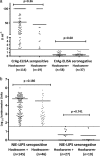Improved diagnosis of Strongyloides stercoralis using recombinant antigen-based serologies in a community-wide study in northern Argentina
- PMID: 20739501
- PMCID: PMC2952987
- DOI: 10.1128/CVI.00259-10
Improved diagnosis of Strongyloides stercoralis using recombinant antigen-based serologies in a community-wide study in northern Argentina
Abstract
The serodiagnosis of Strongyloides stercoralis infection by enzyme-linked immunosorbent assays based on crude antigen (CrAg-ELISA), while useful, has been limited by the reliance on crude parasite extracts. Newer techniques such as the luciferase immunoprecipitation system assay (LIPS), based on a 31-kDa recombinant antigen (termed NIE) from S. stercoralis and/or the recombinant antigen S. stercoralis immunoreactive antigen (SsIR), or the NIE-ELISA have shown promise in controlled settings. We compared each of these serologic assays in individuals from both regions of the world in which S. stercoralis is endemic and those in which it is not. A comprehensive stool evaluation (sedimentation concentration, Baermann concentration with charcoal cultures, agar plate, and Harada-Mori) and four different serologic techniques using CrAg-ELISA or recombinant NIE-ELISA as well as LIPS using NIE alone or in combination with a second recombinant antigen (NIE/SsIR-LIPS) were compared among individuals with parasitologically proven infection (n = 251) and healthy controls from regions of the world in which the infection is nonendemic (n = 11). Accuracy was calculated for each assay. The prevalence of S. stercoralis infection was 29.4% among Argentinean stool samples (n = 228). Sedimentation concentration and Baermann were the most sensitive stool-based methods. NIE-LIPS showed the highest sensitivity (97.8%) and specificity (100%) of the serologic assays. The calculated negative predictive value was highest for both the NIE-LIPS and CrAg-ELISA (>97%) irrespective of disease prevalence. No cross-reactivity with soil-transmitted helminths was noted. NIE-LIPS compares favorably against the current CrAg-ELISA and stool evaluation, providing additional accuracy and ease of performance in the serodiagnosis of S. stercoralis infections irrespective of disease prevalence.
Figures



Similar articles
-
Diagnostic accuracy of a novel enzyme-linked immunoassay for the detection of IgG and IgG4 against Strongyloides stercoralis based on the recombinant antigens NIE/SsIR.Parasit Vectors. 2021 Aug 18;14(1):412. doi: 10.1186/s13071-021-04916-x. Parasit Vectors. 2021. PMID: 34407876 Free PMC article.
-
A luciferase immunoprecipitation systems assay enhances the sensitivity and specificity of diagnosis of Strongyloides stercoralis infection.J Infect Dis. 2008 Aug 1;198(3):444-51. doi: 10.1086/589718. J Infect Dis. 2008. PMID: 18558872 Free PMC article.
-
Comparative study of two commercial tests for Strongyloides stercoralis serologic diagnosis.Trans R Soc Trop Med Hyg. 2018 Dec 1;112(12):561-567. doi: 10.1093/trstmh/try101. Trans R Soc Trop Med Hyg. 2018. PMID: 30219904
-
Novel approaches to the diagnosis of Strongyloides stercoralis infection.Clin Microbiol Infect. 2015 Jun;21(6):543-52. doi: 10.1016/j.cmi.2015.04.001. Epub 2015 Apr 14. Clin Microbiol Infect. 2015. PMID: 25887711 Review.
-
Serodiagnosis and early detection of Strongyloides stercoralis infection.J Microbiol Immunol Infect. 2019 Jun;52(3):371-378. doi: 10.1016/j.jmii.2018.10.001. Epub 2018 Oct 11. J Microbiol Immunol Infect. 2019. PMID: 30482708 Review.
Cited by
-
Adult female of Strongyloides stercoralis in respiratory secretions.Asian Pac J Trop Biomed. 2013 Apr;3(4):311-3. doi: 10.1016/S2221-1691(13)60069-6. Asian Pac J Trop Biomed. 2013. PMID: 23620857 Free PMC article.
-
Design, Expression and Purification of Strongyloides stercoralis IgG4 Immunoreactive Protein (NIE) in Escherichia coli.Iran J Parasitol. 2020 Jul-Sep;15(3):341-348. doi: 10.18502/ijpa.v15i3.4198. Iran J Parasitol. 2020. PMID: 33082798 Free PMC article.
-
Strongyloidiasis: A Disease of Socioeconomic Disadvantage.Int J Environ Res Public Health. 2016 May 20;13(5):517. doi: 10.3390/ijerph13050517. Int J Environ Res Public Health. 2016. PMID: 27213420 Free PMC article. Review.
-
Strongyloidiasis--an insight into its global prevalence and management.PLoS Negl Trop Dis. 2014 Aug 14;8(8):e3018. doi: 10.1371/journal.pntd.0003018. eCollection 2014 Aug. PLoS Negl Trop Dis. 2014. PMID: 25121962 Free PMC article. Review.
-
Mycobacterium leprae infection, Hansen's disease, and helminth infections: A cross-sectional study in southeastern Brazil.medRxiv [Preprint]. 2025 Jun 27:2025.06.26.25330341. doi: 10.1101/2025.06.26.25330341. medRxiv. 2025. PMID: 40666323 Free PMC article. Preprint.
References
-
- Bethony, J., S. Brooker, M. Albonico, S. M. Geiger, A. Loukas, D. Diemert, and P. J. Hotez. 2006. Soil-transmitted helminth infections: ascariasis, trichuriasis, and hookworm. Lancet 367:1521-1532. - PubMed
-
- Brown, M., J. Bukusuba, P. Hughes, J. Nakiyingi, C. Watera, A. Elliott, and J. Whitworth. 2003. Screening for intestinal helminth infestation in a semi-urban cohort of HIV-infected people in Uganda: a combination of techniques may enhance diagnostic yield in the absence of multiple stool samples. Trop. Doct. 33:72-76. - PubMed
-
- Burbelo, P. D., K. H. Ching, T. L. Mattson, J. S. Light, L. R. Bishop, and J. A. Kovacs. 2007. Rapid antibody quantification and generation of whole proteome antibody response profiles using LIPS (luciferase immunoprecipitation systems). Biochem. Biophys. Res. Commun. 352:889-895. - PubMed
Publication types
MeSH terms
Substances
LinkOut - more resources
Full Text Sources
Other Literature Sources

